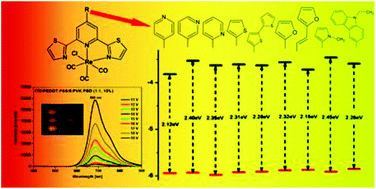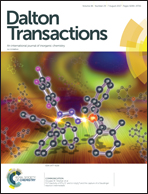Synthesis, spectroscopic, electrochemical and computational studies of rhenium(i) tricarbonyl complexes based on bidentate-coordinated 2,6-di(thiazol-2-yl)pyridine derivatives†
Abstract
Nine rhenium(I) complexes possessing three carbonyl groups together with a bidentate coordinated 2,6-di(thiazol-2-yl)pyridine derivative were synthesized to examine the impact of structure modification of the triimine ligand on the photophysical, thermal and electrochemical properties of [ReCl(CO)3(4-Rn-dtpy-κ2N)]. The Re(I) complexes were fully characterized using IR, 1H and 13C, HRMS-ESI and single crystal X-ray analysis. Their thermal properties were evaluated using DSC and TGA measurements. Photoluminescence spectra of [ReCl(CO)3(4-Rn-dtpy-κ2N)] were investigated in solution and in the solid state, at 298 and 77 K. Both emission wavelengths and quantum yields of [ReCl(CO)3(4-Rn-dtpy-κ2N)] were found to be structure-related, demonstrating a crucial role of the substituent attached to the 2,6-di(thiazol-2-yl)pyridine skeleton. In order to fully understand the photophysical properties of [ReCl(CO)3(4-Rn-dtpy-κ2N)], density functional theory (DFT) and time-dependent DFT (TD-DFT) calculations were performed. Furthermore, the complexes which showed appropriate solubility in chloroform were tested as an emissive active layer in OLED devices.



 Please wait while we load your content...
Please wait while we load your content...